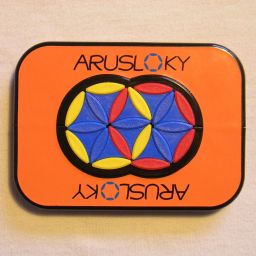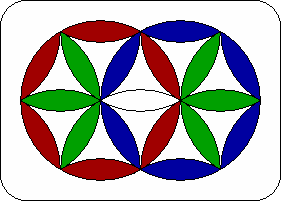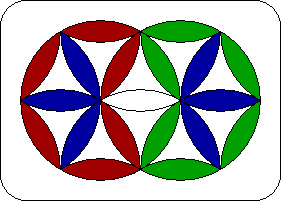



The Cohan Circle consists of two overlapping circular discs. The distance between the centres is exactly one radius length. The discs are made up of many pieces with curved sides, which allow them to be rotated any number of 1/6th turns. Each disc has 6 blank triangles, and 12 petal-shaped pieces. As some pieces are shared between the two discs, there are all together 10 triangles and 19 petals.
The 19 petals come in 4 colours - 6 red, 6 green, 6 blue, and 1 white. The aim is to make the 6 peripheral pieces of each disc of a single colour, forming two circles, and also place the white piece in the centre.
This puzzle was invented and patented by Hooshang Cohan, number US 4,580,783 published 8 April 1986. It may have been sold as the 'Magic Circle Puzzle', as the solution booklet has that title covered by a label with the correct name.
Arusloky is a recent version of this puzzle, made in Spain. It has a slightly different colour scheme, with 6 red petals, 6 yellow petals, and everything else blue. Its starting configuration has a red and a yellow circle.
If your browser supports it, you can click on the link below to play with a Javascript version of both the Cohan Circle and Arusloky.
I have used a computer to calculate God's algorithm for the Cohan Circle. This first table shows the results if the two circles may be any colour. Any position can be solved in at most 14 moves (10.892 on average), or 20 (16.447 on average) if every 1/6 of a turn is counted as a separate move.
| Face turn metric | ||||||||||||||||||
|---|---|---|---|---|---|---|---|---|---|---|---|---|---|---|---|---|---|---|
| S i x t h t u r n m e t r i c |
0 | 1 | 2 | 3 | 4 | 5 | 6 | 7 | 8 | 9 | 10 | 11 | 12 | 13 | 14 | Total | ||
| 0 | 6 | 6 | ||||||||||||||||
| 1 | 24 | 24 | ||||||||||||||||
| 2 | 24 | 48 | 72 | |||||||||||||||
| 3 | 12 | 96 | 96 | 204 | ||||||||||||||
| 4 | 96 | 288 | 192 | 576 | ||||||||||||||
| 5 | 48 | 432 | 768 | 360 | 1,608 | |||||||||||||
| 6 | 12 | 384 | 1,536 | 1,920 | 672 | 4,524 | ||||||||||||
| 7 | 216 | 1,920 | 4,800 | 4,512 | 1,344 | 12,792 | ||||||||||||
| 8 | 72 | 1,656 | 7,656 | 13,776 | 10,368 | 2,688 | 36,216 | |||||||||||
| 9 | 6 | 888 | 8,472 | 26,832 | 37,416 | 23,292 | 5,220 | 102,126 | ||||||||||
| 10 | 288 | 6,744 | 37,056 | 85,908 | 96,984 | 51,768 | 9,120 | 287,868 | ||||||||||
| 11 | 48 | 3,816 | 38,160 | 141,492 | 260,832 | 248,160 | 105,924 | 11,448 | 809,880 | |||||||||
| 12 | 1,392 | 28,188 | 177,636 | 506,928 | 778,632 | 607,140 | 159,156 | 4,800 | 2,263,872 | |||||||||
| 13 | 264 | 15,624 | 168,576 | 759,792 | 1,800,432 | 2,286,288 | 1,119,540 | 86,400 | 120 | 6,237,036 | ||||||||
| 14 | 48 | 5,904 | 122,160 | 887,700 | 3,250,272 | 6,454,830 | 5,176,068 | 709,416 | 2,496 | 16,608,894 | ||||||||
| 15 | 1,560 | 63,696 | 789,708 | 4,544,274 | 14,003,772 | 17,464,728 | 3,783,360 | 25,164 | 40,676,262 | |||||||||
| 16 | 264 | 22,056 | 471,384 | 4,445,148 | 21,498,660 | 41,519,520 | 13,868,748 | 160,134 | 81,985,914 | |||||||||
| 17 | 24 | 3,672 | 149,352 | 2,358,984 | 18,030,234 | 56,024,250 | 30,471,336 | 609,204 | 24 | 107,647,080 | ||||||||
| 18 | 168 | 15,528 | 430,644 | 5,324,604 | 27,410,358 | 26,806,164 | 1,134,564 | 48 | 61,122,078 | |||||||||
| 19 | 264 | 12,372 | 281,952 | 2,435,406 | 4,791,876 | 509,670 | 24 | 8,031,564 | ||||||||||
| 20 | 564 | 12,024 | 52,134 | 16,266 | 80,988 | |||||||||||||
| Total | 6 | 60 | 300 | 1,494 | 7,296 | 35,472 | 172,572 | 834,492 | 3,964,452 | 17,925,906 | 68,603,088 | 151,332,498 | 80,574,234 | 2,457,618 | 96 | 325,909,584 | ||
This table shows the results if the circles must have particular colours. Any position can be solved in at most 17 moves (12.230 on average), or 23 (18.339 on average) if every 1/6 of a turn is counted as a separate move.
| Face turn metric | |||||||||||||||||||||
|---|---|---|---|---|---|---|---|---|---|---|---|---|---|---|---|---|---|---|---|---|---|
| S i x t h t u r n m e t r i c |
0 | 1 | 2 | 3 | 4 | 5 | 6 | 7 | 8 | 9 | 10 | 11 | 12 | 13 | 14 | 15 | 16 | 17 | Total | ||
| 0 | 1 | 1 | |||||||||||||||||||
| 1 | 4 | 4 | |||||||||||||||||||
| 2 | 4 | 8 | 12 | ||||||||||||||||||
| 3 | 2 | 16 | 16 | 34 | |||||||||||||||||
| 4 | 16 | 48 | 32 | 96 | |||||||||||||||||
| 5 | 8 | 72 | 128 | 60 | 268 | ||||||||||||||||
| 6 | 2 | 64 | 256 | 320 | 112 | 754 | |||||||||||||||
| 7 | 36 | 320 | 800 | 752 | 224 | 2,132 | |||||||||||||||
| 8 | 12 | 276 | 1,276 | 2,296 | 1,728 | 448 | 6,036 | ||||||||||||||
| 9 | 1 | 148 | 1,412 | 4,472 | 6,228 | 3,882 | 886 | 17,029 | |||||||||||||
| 10 | 48 | 1,124 | 6,176 | 14,274 | 16,120 | 8,616 | 1,692 | 48,050 | |||||||||||||
| 11 | 8 | 636 | 6,356 | 23,458 | 42,966 | 40,720 | 18,478 | 2,824 | 135,446 | ||||||||||||
| 12 | 232 | 4,698 | 29,350 | 82,436 | 124,540 | 99,918 | 36,040 | 3,412 | 380,626 | ||||||||||||
| 13 | 44 | 2,592 | 27,720 | 121,962 | 277,178 | 351,736 | 228,020 | 52,524 | 2,124 | 1,063,900 | |||||||||||
| 14 | 8 | 976 | 20,198 | 140,820 | 479,742 | 917,036 | 949,630 | 393,298 | 37,832 | 452 | 2,939,992 | ||||||||||
| 15 | 276 | 10,922 | 126,848 | 659,986 | 1,881,553 | 2,944,068 | 1,957,096 | 333,158 | 7,508 | 40 | 7,921,455 | ||||||||||
| 16 | 52 | 4,156 | 83,990 | 705,670 | 3,058,200 | 7,133,672 | 7,192,355 | 1,946,768 | 72,652 | 286 | 20,197,801 | ||||||||||
| 17 | 8 | 916 | 37,364 | 535,082 | 3,650,050 | 13,005,940 | 19,870,446 | 8,252,463 | 477,295 | 2,534 | 4 | 45,832,102 | |||||||||
| 18 | 92 | 8,816 | 235,294 | 2,683,637 | 15,260,696 | 37,434,232 | 24,801,555 | 2,247,136 | 16,510 | 12 | 82,687,980 | ||||||||||
| 19 | 724 | 44,184 | 914,164 | 8,785,580 | 37,350,460 | 44,032,082 | 6,982,224 | 81,080 | 24 | 98,190,522 | |||||||||||
| 20 | 20 | 2,500 | 100,576 | 1,698,982 | 13,116,080 | 31,080,478 | 10,325,245 | 247,016 | 90 | 56,570,987 | |||||||||||
| 21 | 20 | 1,884 | 61,496 | 884,178 | 4,605,371 | 3,867,105 | 267,436 | 188 | 1 | 9,687,679 | |||||||||||
| 22 | 92 | 3,294 | 47,380 | 135,162 | 40,391 | 109 | 226,428 | ||||||||||||||
| 23 | 12 | 76 | 160 | 2 | 250 | ||||||||||||||||
| Total | 1 | 10 | 50 | 249 | 1,216 | 5,912 | 28,766 | 139,266 | 666,396 | 3,114,418 | 13,678,924 | 50,107,040 | 118,257,375 | 115,139,223 | 24,114,855 | 655,453 | 429 | 1 | 325,909,584 | ||
The single position that takes 17 face turns is L R' L R' L R2 L2 R L' R L' R' L2 R4 L' R4 L, which has the two circle colours swapped.
Here are the results for the Arusloky. This first table shows the results if the two circle colours may be swapped so there are two solutions. Any position can be solved in at most 14 moves (10.556 on average), or 20 (15.763 on average) if every 1/6 of a turn is counted as a separate move.
| Face turn metric | |||||||||||||||||||
|---|---|---|---|---|---|---|---|---|---|---|---|---|---|---|---|---|---|---|---|
| S i x t h t u r n m e t r i c |
0 | 1 | 2 | 3 | 4 | 5 | 6 | 7 | 8 | 9 | 10 | 11 | 12 | 13 | 14 | Total | |||
| 0: | 2 | 2 | |||||||||||||||||
| 1: | 8 | 8 | |||||||||||||||||
| 2: | 8 | 16 | 24 | ||||||||||||||||
| 3: | 4 | 32 | 32 | 68 | |||||||||||||||
| 4: | 32 | 96 | 64 | 192 | |||||||||||||||
| 5: | 16 | 144 | 256 | 120 | 536 | ||||||||||||||
| 6: | 4 | 120 | 512 | 636 | 224 | 1,496 | |||||||||||||
| 7: | 72 | 608 | 1,576 | 1,488 | 448 | 4,192 | |||||||||||||
| 8: | 16 | 496 | 2,348 | 4,520 | 3,472 | 840 | 11,692 | ||||||||||||
| 9: | 2 | 232 | 2,544 | 8,464 | 12,300 | 7,668 | 1,572 | 32,782 | |||||||||||
| 10: | 56 | 1,896 | 11,220 | 27,524 | 32,160 | 16,136 | 2,376 | 91,368 | |||||||||||
| 11: | 8 | 888 | 10,716 | 44,052 | 85,032 | 80,864 | 29,260 | 2,240 | 253,060 | ||||||||||
| 12: | 288 | 7,432 | 52,244 | 162,592 | 256,720 | 177,912 | 33,772 | 592 | 691,552 | ||||||||||
| 13: | 48 | 3,824 | 46,584 | 235,762 | 591,050 | 694,446 | 249,480 | 11,392 | 8 | 1,832,594 | |||||||||
| 14: | 1,144 | 29,972 | 253,296 | 1,023,098 | 1,953,822 | 1,173,934 | 93,470 | 160 | 4,528,896 | ||||||||||
| 15: | 208 | 11,748 | 184,548 | 1,245,360 | 3,890,792 | 3,779,374 | 484,264 | 1,792 | 9,598,086 | ||||||||||
| 16: | 24 | 2,356 | 72,648 | 875,036 | 4,595,956 | 7,487,246 | 1,607,840 | 9,546 | 14,650,652 | ||||||||||
| 17: | 176 | 11,992 | 253,348 | 2,253,812 | 6,564,972 | 2,629,030 | 31,300 | 11,744,630 | |||||||||||
| 18: | 8 | 440 | 17,044 | 265,496 | 1,447,556 | 1,237,330 | 35,884 | 3,003,758 | |||||||||||
| 19: | 120 | 3,052 | 33,622 | 69,858 | 6,158 | 6 | 112,816 | ||||||||||||
| 20: | 8 | 28 | 56 | 16 | 108 | ||||||||||||||
| Total: | 2 | 20 | 100 | 482 | 2,232 | 10,344 | 49,264 | 230,884 | 1,046,978 | 4,360,348 | 13,866,932 | 20,772,224 | 6,133,832 | 84,864 | 6 | 46,558,512 | |||
And finally, this table shows the results if the Arusloky has only one solved position. This can be reached from any position in at most 15 moves (11.223 on average), or 22 (16.657 on average) if every 1/6 of a turn is counted as a separate move.
| Face turn metric | |||||||||||||||||||
|---|---|---|---|---|---|---|---|---|---|---|---|---|---|---|---|---|---|---|---|
| S i x t h t u r n m e t r i c |
0 | 1 | 2 | 3 | 4 | 5 | 6 | 7 | 8 | 9 | 10 | 11 | 12 | 13 | 14 | 15 | Total | ||
| 0: | 1 | 1 | |||||||||||||||||
| 1: | 4 | 4 | |||||||||||||||||
| 2: | 4 | 8 | 12 | ||||||||||||||||
| 3: | 2 | 16 | 16 | 34 | |||||||||||||||
| 4: | 16 | 48 | 32 | 96 | |||||||||||||||
| 5: | 8 | 72 | 128 | 60 | 268 | ||||||||||||||
| 6: | 2 | 60 | 256 | 318 | 112 | 748 | |||||||||||||
| 7: | 36 | 304 | 788 | 744 | 224 | 2,096 | |||||||||||||
| 8: | 8 | 248 | 1,174 | 2,260 | 1,736 | 420 | 5,846 | ||||||||||||
| 9: | 1 | 116 | 1,272 | 4,232 | 6,150 | 3,834 | 786 | 16,391 | |||||||||||
| 10: | 28 | 948 | 5,610 | 13,758 | 16,072 | 8,064 | 1,208 | 45,688 | |||||||||||
| 11: | 4 | 444 | 5,358 | 22,022 | 42,442 | 40,258 | 14,750 | 1,348 | 126,626 | ||||||||||
| 12: | 144 | 3,716 | 26,110 | 80,992 | 127,024 | 88,646 | 19,282 | 728 | 346,642 | ||||||||||
| 13: | 24 | 1,912 | 23,264 | 117,171 | 289,206 | 338,453 | 140,389 | 13,072 | 196 | 923,687 | |||||||||
| 14: | 572 | 14,974 | 125,532 | 495,119 | 927,789 | 650,840 | 111,670 | 3,338 | 16 | 2,329,850 | |||||||||
| 15: | 104 | 5,878 | 91,974 | 603,414 | 1,831,240 | 2,107,752 | 614,308 | 29,032 | 216 | 5,283,918 | |||||||||
| 16: | 12 | 1,218 | 37,564 | 448,179 | 2,324,322 | 4,591,719 | 2,299,538 | 180,077 | 1,962 | 4 | 9,884,595 | ||||||||
| 17: | 104 | 7,200 | 162,248 | 1,522,560 | 5,615,744 | 5,304,343 | 741,553 | 11,672 | 32 | 13,365,456 | |||||||||
| 18: | 4 | 512 | 20,669 | 382,822 | 2,791,664 | 5,621,094 | 1,675,960 | 47,070 | 190 | 10,539,985 | |||||||||
| 19: | 8 | 694 | 23,010 | 352,898 | 1,660,611 | 1,283,154 | 92,716 | 762 | 3,413,853 | ||||||||||
| 20: | 4 | 116 | 4,714 | 61,760 | 158,713 | 43,429 | 964 | 269,700 | |||||||||||
| 21: | 2 | 102 | 1,057 | 1,626 | 224 | 3,011 | |||||||||||||
| 22: | 2 | 3 | 5 | ||||||||||||||||
| Total: | 1 | 10 | 50 | 241 | 1,116 | 5,172 | 24,632 | 115,442 | 523,721 | 2,195,665 | 7,454,916 | 16,276,352 | 15,687,226 | 4,073,080 | 198,709 | 2,179 | 46,558,512 | ||
 |
 |
 |
 |
| The left circle is the 6 piece locations that lie on the rim of the left disk. Eventually all the pieces of one colour will be placed in the left circle. Similarly, the right circle is the 6 locations on the rim of the right disk, which will be made another colour. | The left extended circle is the left circle plus the horizontal piece location at the right hand side. Note that the 7 pieces in the left extended circle will remain in the left extended circle if you do R2, R4, or L moves. Similarly the right extended circle is the right circle plus the left horizontal piece location. | The spokes of the left disk are the six locations of the left disk that meet in the centre, i.e. those locations that lie inside the left circle. Similarly the spokes of the right disk are the six locations that meet in the centre of the right disk. | The middle is the central horizontal location where the white piece should be when the puzzle is solved. Note that this is a left spoke as well as a right spoke. |
Phase 1: Put the green/yellow pieces in the left extended circle.
Phase 2: Put the red pieces in their extended circle.
Phase 3: Make the circles.
Phase 4: Place the white petal in the centre.
| Start position. |  |
 |
|||
| 1. | Swap circles. | L R L4 R L R' L R' L' R2 L4 R L' R L' R L' R' |  |
 |
L' R' L R' L R' L2 R4 L2 R2 L' R' L4 R' L |
| 2. | Swap right circle with spokes. | L R' L R4 L R L' R L R L R L3 R' L' |  |
||
| 3. | Wagonwheel. | R L' R' L R L2 R3 L2 R' L3 R L R |  |
 |
L' R' L4 R3 L2 R L2 R4 L R2 |
| 4. | Pacman. | R' L R4 L' R L3 R' L R3 L4 R3 L4 |  |
 |
L' R4 L R' L R' L2 R4 L R4 L2 |
| 5. | Hourglass. | R L R2 L R' L2 R2 L2 R' L R3 L' R L4 |  |
 |
R3 L4 R L' R L4 R4 L R' L R' L R2 L4 |
| 6. | Fish. | L' R' L R' L R L R L' R' L R2 L' R3 L3 |  |
 |
L R L' R L R' L4 R' L R L R L4 R4 |